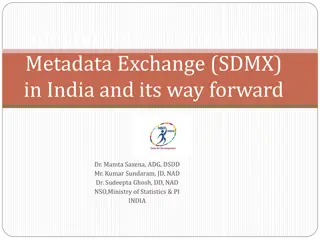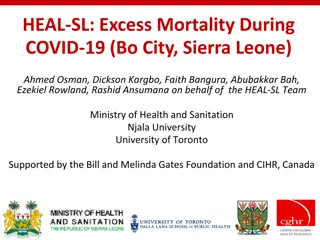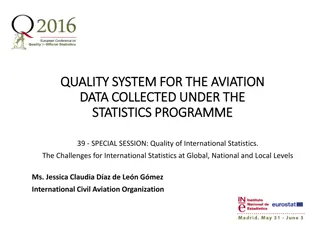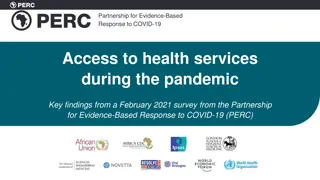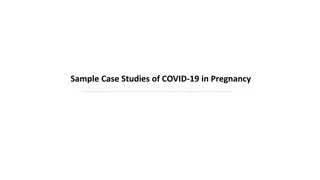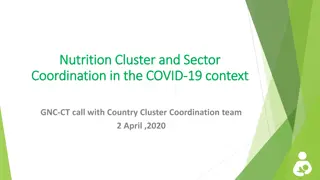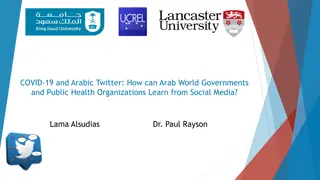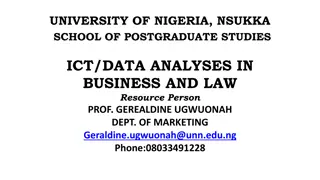Impact of COVID-19 on Data Analysis and Comparability Over Time
The COVID-19 pandemic has significantly affected data analysis processes, with changes in data items, census reference dates, and collection methodologies. This has led to challenges in maintaining comparability over time. The presentation covers the background, changes in data items, South African multidimensional poverty indicators, methodological implications, and the effects of the pandemic on timing census activities. Key issues include population stability, biases in estimates, and potential deviations in data.
Download Presentation

Please find below an Image/Link to download the presentation.
The content on the website is provided AS IS for your information and personal use only. It may not be sold, licensed, or shared on other websites without obtaining consent from the author. Download presentation by click this link. If you encounter any issues during the download, it is possible that the publisher has removed the file from their server.
E N D
Presentation Transcript
Effects of the Covid-19 pandemic on data analysis and comparability over time Presentation to the EGM meeting Session 5 1
Presentation outline Background 1 Changes in data items; 2 Moving Census reference date; 3 Changing methodology; 4 Conclusion 5
Background In most countries, the impact of COVID-19 pandemic has been and will continue to be felt throughout all census phases, data, analysis and dissemination in particular; Comparability over time might be compromised mainly due to: o Changes in questionnaire data items o Shifting of Census reference date o Changes in methods of collection
Changes in data Items Inability to provide adequate frame for surveys Limited data items to accommodate CATI & CAWI Inability to adequately test adjusted instruments
South African Multidimensional Poverty indicators (SAMPI) incorporates Census variables Child mortality (death of child under 5) Health Years of schooling (completed 5 years of schooling) School attendance (school-aged child out of school) Education Lighting (no electricity) Heating (no electricity) Cooking (no electricity) Living standards Water (no piped water) Sanitation (no flush toilet) Dwelling Economic activity (informal/traditional/caravan/tent) Assets (no radio/TV/phone/car) Unemployment (adults unemployed)
Methodological implications Household based Population Homeless Population De facto Census De facto Census Institution based population Transient
Effects of COVID-19 pandemic on timing Census activity/process changes Data issues introduced Adjust geography frame to accommodate adopted collection modes Introduces biases in dwelling unit and household estimates Delayed/prolonged collections Introduces bias in Census estimates due to recall effect Limited population stability during enumeration Population movement effect on final estimate Possible deviation from required population stability (e.g. In SA; October vs February/July)
Changes in response patterns Census activity/process changes Data issues introduced Effect on population count/ events e.g. migration patterns, labour force activities, student holiday during lock down Comparability of data with previous Census compromised Application of sampling methodology Comparability of data with previous Census compromised Changes in question wording Impact on interpretation of the question & the estimate
Introduction of unplanned activities Census activity/process changes Data issues introduced Changed methods, processes and systems in census activities e.g. introduction of online questionnaire completion Inadequate time to conduct thorough testing before implementation in main Census introduces errors in Census data Use of a combination of admin data and census data in final Census estimates Introduction of errors as a result of inadequate data integration techniques, editing methods
Biases in Census results Changes introduced: processes & timing Data issues introduced Use of admin data for imputation Use of alternative statistical methods to adjust Census results Introduce bias in Census estimates Distorts data and results in high imputation rates Effect on data editing and imputation
Conclusion Conducting Census using traditional approach amidst COVID-19 pandemic led to adjustment in methods, procedures and collection tools To reduce pandemic impact on overall census product and ensure comparability of data overtime Enhancement in metadata to assist users in understanding unusual patterns




